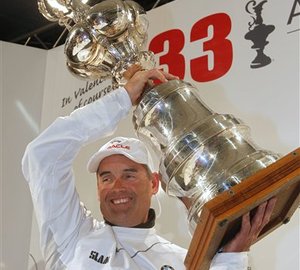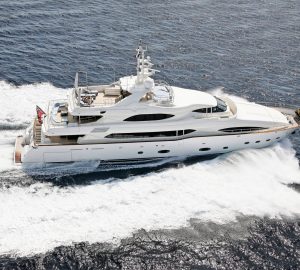An important step was taken towards creating the next America’s Cup boat when 19 designers met in Valencia. The main point of discussion was, whether to develop a monohull or a multihull for the 34th America’s Cup.
The conference was held at the home base of BMW ORACLE Racing during its successful 33rd America’s Cup campaign.
“The teams want a new boat; the fans deserve one too,” commented Russell Coutts, four time winner of the America’s Cup.
“It will not be a ‘defender’s boat’. It will be the product of genuine discussion and dialogue,” Coutts added.
The Valencia meetings were chaired by BMW ORACLE Racing’s design coordinator, Ian Burns. Around the table 10 nationalities were represented, with winning records in every level rating class from Quarter Tonners to TP52s as well as the Volvo Ocean Race, Jules Verne Trophy, classic races such as the Fastnet and Sydney-Hobart and, the America’s Cup.
Structural and performance experts also attended as did those with experience of creating rules for the ACC, Whitbread 60 and Volvo 70 classes. Two different multihulls (20m and 25m LOA) were discussed as was one monohull (up to 27m LOA). The new concepts were conceived by eminent designers Bruce Nelson and Morelli/Melvin, creators of previous America’s Cup winning yachts. Besides their expertise, Nelson and Morelli/Melvin were chosen because they are unaligned with either BMW ORACLE Racing or the Challenger of Record, Club Nautico di Roma/Mascalzone Latino.
High performance is fundamental to all three concepts. The monohull proposal will give significantly faster speeds upwind and downwind compared to boats used in 2007.
“The America’s Cup is the pinnacle of our sport, so the boats should be physically demanding to race well and produce fast, competitive racing to engage new fans,” said Burns.
• – fast, dynamic and close racing
• – high levels of athleticism required to race the boats to their optimum
• – advanced, efficient and cost-effective technologies
• – logistical efficiency to facilitate transport to a regular series of regattas
• – distinctive to the America’s Cup
• – versatility, enabling racing in any venue in winds from 5-35 knots
Versatility is seen as essential to minimise disruption to racing.
“Delays and postponements kill interest,” commented Coutts. “America’s Cup boats shouldn’t be the last to start racing and the first to quit whilst other classes are still racing. They also need to be designed from the outset to unleash the full potential of television.”
Television specialists will provide expertise and advice before the rule is written so that media requirements are incorporated at the outset.
The World Sailing Teams Association has been asked if it would manage the rule drafting. Non-aligned experts will be used to ensure fairness to all teams.
The rule-writers will report back to all teams equally and frequently. And teams will have the chance to review the new rule before it is finalised.
Publication of the new class rule will be no later than 30th September.






















